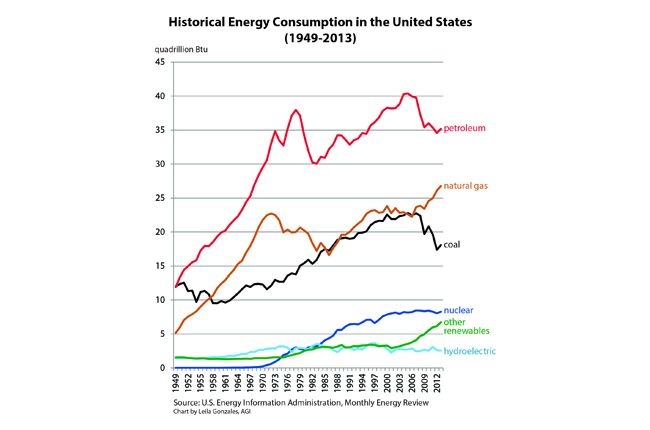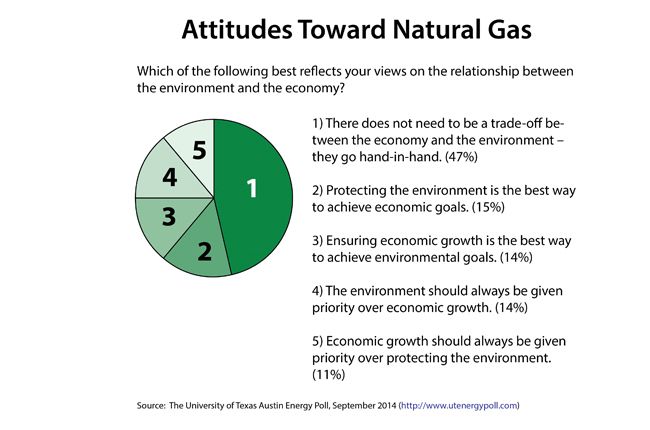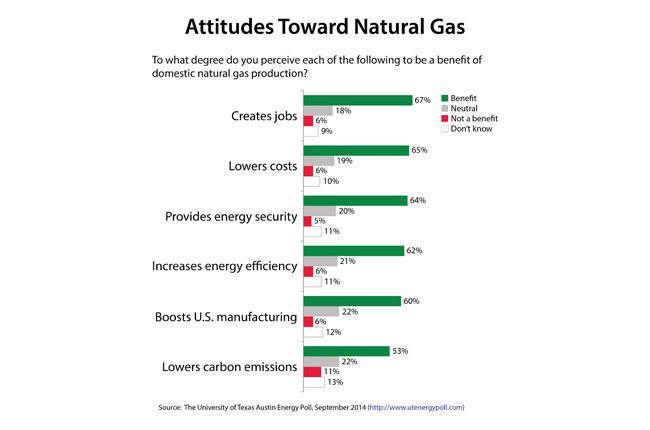America's Increasing Reliance on Natural Gas: Benefits and Risks of a Methane Economy: Report of the Critical Issues Forum
![]() Download the 2014 AGI Critical Issues Forum final report
Download the 2014 AGI Critical Issues Forum final report
Purchase a printed version ($10.00)
Every day, most Americans work, study or relax in climate-controlled, well-lit rooms. Every day, most Americans make phone calls or send emails, wash their hands with clean water and pull food from refrigerators. And every day, most of the 319 million Americans either ride in one of the 253 million vehicles on the road, or take a subway, train, plane, boat or some other means of transportation.
That all of these activities — integral to our daily lives — require energy won’t come as news to anyone. But the amount of energy needed to fuel our way of life is often under-appreciated, and rarely do we give much thought to where the energy that drives modern life is sourced. Even with great advances in efficiency, total energy use today in the United States is twice what it was 50 years ago, and globally we trail only China, which has a population more than four times as large. On average, each American consumes the equivalent of about 2,420 gallons of oil annually — more per person than in any other of the world’s 35 most-populous nations.
Visualize 2,420 gallons of oil multiplied by 319 million people, and the enormous scale of our energy requirement comes into focus. Supplying all that energy — from sources that are affordable, accessible, reliable and sustainable — is a challenge equally enormous. Since the early 20th century, abundant, energy-dense fossil fuels including petroleum, natural gas and coal have been our go-to sources to meet most demand. And that continues today, with those three fuels accounting, respectively, for 36, 27 and 18 percent of all U.S. energy consumption. Of course, we use other sources as well: nuclear (9 percent of total U.S. energy usage), hydroelectric (3 percent), and renewable sources such as biomass, wind, geothermal and solar (6 percent combined).
The mix of sources we’ve used has long been dynamic, shifting historically — though largely out of the public eye — in response to changes in supply, demand, U.S and global economic activity, technological innovation and available infrastructure. The U.S. led the world in total petroleum production until the 1970s, after which it was eclipsed by output from other countries. But since the mid-2000s, U.S. oil and gas production has seen a resurgence, fueled by advances in technology and geologic understanding.
The economic potential of the current oil and gas boom is undeniable for the United States, both as an engine of economic growth and as a measure of energy security. Yet, the rapid expansion of the domestic footprint of energy development has also dramatically increased awareness of the challenges involved. And increased publicity about the potential hazards and impacts of energy production and transport has led to conversations about energy and the environment that have grown louder and more fraught with emotion, giving the impression of an issue defined by strongly entrenched positions and with little opportunity to find common, or middle, ground.
However, there is more opportunity than there might seem. Most Americans do not perceive economic and environmental prosperity as an either-or proposition — quite the opposite. According to polling by the University of Texas at Austin, for example, roughly half of respondents said that economic and environmental concerns go “hand-in-hand,” whereas just one-quarter said that one or the other “should always be given priority” over the other.
When it comes to energy, every source has upsides and downsides — whether due to cost, accessibility, reliability or potential as a hazard. As with all complex problems, there is no easy, single solution to solving the future energy requirements of a growing economy. But inflexibility and an unwillingness to consider alternative ideas is a recipe for stagnation, not success. And finding common ground — on the desire for ample affordable energy and for a continued push for the implementation of best practices in energy production and environmental protection, for example — through open and honest communication is paramount in ensuring we can maintain the high standards of living we enjoy across the country. Based on current and expected future energy demands in the U.S., coupled with the anticipated availability of resources and infrastructure, the U.S. will continue to rely on a diverse mix of energy sources in the coming decades. This mix will most likely still be led by fossil fuels because the technology and infrastructure for efficient generation and/or transmission of power from sources like nuclear and renewables is expected to be inadequate to fulfill the majority of our demand in the near future. And improved supply of fossil fuels, especially natural gas, will likely play a critical role in bridging the transition of the economy towards future energy sources.
Renewable energy consumption has been growing annually by about 6 percent on average since 2008, thanks largely to tax credits and government investments that have stimulated research and development. Sustaining that brisk pace, however, will be difficult due to the ever-increasing need for materials to build the required infrastructure, as well as the land (or sea) surface area on which to install it. And even if this pace were sustained, it would still take until mid-century for renewable consumption to equal current fossil fuel consumption. This is not an argument against development of non-fossil resources, but is instead one illustration of the challenge of transitioning away from a fossil fuel-dominated economy.
In recent years, natural gas, which is composed mostly of methane, has emerged as an appealing option to meet the majority of our energy needs — thanks in large part to new technologies that allow gas to be extracted from shale rock buried below the surface. Natural gas has particular advantages for the U.S.: There is a large domestic supply; it burns more efficiently than petroleum and coal so it releases less carbon dioxide into the atmosphere than those two fuels; and it is already in common use in many areas — meaning the base infrastructure needed to convert to a natural gas-led energy economy is already in place. Yet, natural gas has drawbacks as well: It contains less energy per volume than other fossil fuel sources, creating difficulties for transporting and storing it, as well as for its use as a transportation fuel; it still produces more carbon dioxide than renewable sources; and although some infrastructure exists to support heavy gas consumption, more would be needed in a majority- methane economy.
For all we do know about natural gas, there is more we don’t. Recognizing this and that we as individuals, states and a country must make critical decisions about where our future energy will come from — the American Geosciences Institute (AGI) convened a meeting of experts to analyze the potential for a methane-dominant economy in the U.S. This first-of-its-kind Critical Issues Forum brought geoscientists, economists and other natural gas experts from academia, industry, government and nongovernmental organizations (NGOs) together to consider issues of supply, demand and environmental health and public safety related to natural gas, as well as the barriers to and enablers of a potential methane economy. The goal was not to formulate a singular position or suggest specific policy, but rather to foster open, frank dialogue about a critically important issue and to explore how the varied interests in a methane future might best find compromise to advance our common energy goals.
This report offers an overview of the key conceptual ideas that arose in the forum and outlines the suggested approaches that different stakeholder groups can take to advance the conversation on energy in the U.S.
![]() Download the 2014 AGI Critical Issues Forum final report
Download the 2014 AGI Critical Issues Forum final report
Purchase a printed version ($10.00)
Learn More
- Energy Topics (Webpage), American Geosciences Institute, Critical Issues Program
- Oil and Gas Basics (Webpage), American Geosciences Institute, Critical Issues Program







